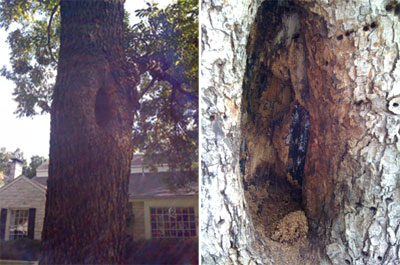Question and Answer – February 2012
This is one of the most popular parts of e-gardens, and a big reason for that would be the photos you send with your questions. People can see if the problem they have is the same as the problem you have. That’s why I only choose questions that are accompanied by related photos. Here are the questions from this month.
Question: Do you have any advice regarding this large pecan tree? A large truck knocked off a branch several years ago. We trimmed up the area around the break, but we did nothing else, thinking the tree would heal itself. Last fall I noticed the hole. Since that area faces the street, I had not noticed it before. This is a large tree and it has dropped many big limbs this last year. We are concerned we could lose it if the rotting continues. Any suggestions? C.A., Dallas.
Answer: I had my own feelings about how best to handle this tree. I live in a pecan forest, and I see things not too dissimilar in some of my trees from time to time. But, I thought it might be great to get word from the master, so I sent your photos and question on to Steve Houser, owner of Arborilogical Services of DFW. Here is what he replied:
"In essence, the pecan appears healthy, and there is no obvious reason to believe that the tree would be lost due to health concerns. Trees compartmentalize wounds by growing new tissue on the sides of their wounds. In this case, the wound is now much smaller and could be expected to be fully closed (or compartmentalized) in the years to come. The small round holes in the bark are due to a type of woodpecker and are not a great concern to the health of the tree at this point. There is a small amount of sawdust in the base of the wounded area that may indicate wood borer activity (a wood-boring insect), or it could possibly be from another cause. An occasional borer entering into a wound of a very healthy tree is not a great cause for alarm or treatment. A heavy infestation could be a problem, but the photos do not show reason for a great concern.
"Although the rot and decay may appear to be a concern, as the wound heals (compartmentalizes), it becomes stronger, which helps to offset the decay.
"If limbs were lost in the upper parts of the tree last year, the most likely suspect is a buildup of weight on the ends of longer limbs (the photos do not show the upper parts of the tree). Proper pruning includes the removal of foliage and limbs (or end weight) on longer limbs, which reduces the odds of limb breakage. It is difficult and time consuming [for someone] to climb out on the ends of the limbs, but it is very important, as pecans (and other fruit-producing species) grow larger over time. In some cases, cabling or bracing of limbs is recommended for limbs with a weak angle of attachment. Also, weight reduction on longer limbs helps to reduce the stress on the trunk and the area of decay noted above."
Question: We have several native eastern redcedars. We transplanted some, and birds gifted us with others. I thought they had made it through last summer, even though they did not get watered, but now, they’re turning brown. Are they goners? Is there some other plant that would be better? I like it that they’re green in the winter. J.N., 14 miles west of Denton.
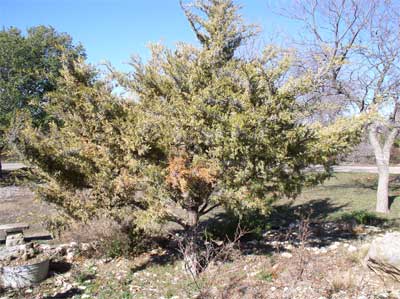
Answer: This is drought damage, and I’ve seen the same thing happening all over Texas. Plants we thought were going to be alive are only now failing. If your plants go ahead and turn completely brown and brittle, they’re not going to come back. However, eastern redcedar remains the very best evergreen screening tree for big parts of Texas. 2011 was just extraordinarily bad for them. More mature, bigger trees seem to have fared much better across the state. My vote would be to replant with more 12-inch specimens some December, after this current drought has abated.
Question: Since the cooler weather, this weed has started taking over my monkeygrass bed. I’ve tried several weedkillers, but with no luck. What can I do to eliminate it? J.S., Crowley.
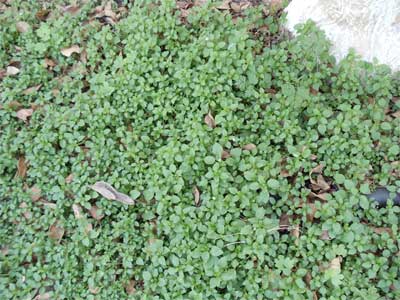
Answer: This looks like chickweed, but absolute ID isn’t important. It’s a broadleafed weed, so a broadleafed weedkiller (containing 2,4-D) would be the control. But, there’s a major problem. That product would also be very harmful to the monkeygrass, so if they’re in the same vicinity, hand-pulling or hoeing will probably be your only alternatives. The good news is that the mondograss will probably become so thick over this summer that you won’t have to worry about the weed getting back in. However, if you’re still concerned by the end of this summer that it might crop up in some bare spots, you could apply a pre-emergent weedkiller the first week of September. Your local independent retail garden center could show you the options.
Question: I think this hedgerow has really been hurt by last summer’s drought. I’ve trimmed out the dead wood, but the plants appear to be declining even more. They are near a large oak tree, also a large mulberry, so the trees may have gotten the water. Is there anything I can do to save them? L.C., no city given.

Answer: I had trouble zooming in on the leaves, but they appear to be of a euonymus hedge. If so, drought can really do a number on that plant, and only time will tell how serious the damage might be. You should know the extent of the dieback within the next six or eight weeks. If they don’t green up and offer to grow this coming spring, they’re probably goners. Other shrubs might prove more dependable in the long run, depending on where you are and what your needs are. As with other times here, I’d refer you to a local independent retail garden center in your area.
Question: My iris has had rolled leaves for the past two years, and they’ve produced no blooms. How should I treat the problem? J.S., Arlington.
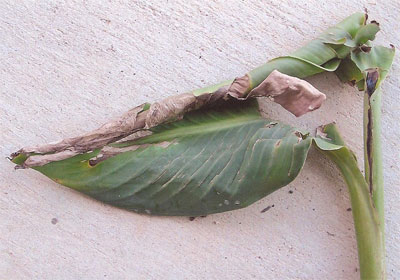
Answer: Actually, you’re growing cannas, and this is the damage of the canna leaf roller. It’s a pest that attacks starting late each spring. It forms its "house" by rolling the leaves together. It chews through the rolled leaf, and, as the leaf may try to unfurl, you’ll see rows of holes across it. It also slows or stops the formation of flower spikes. Your best control would be a systemic insecticide. Apply it, probably to the soil, three or four weeks prior to the date when you first saw the pest last summer. It will need time to be taken in through the roots and up to the leaves.
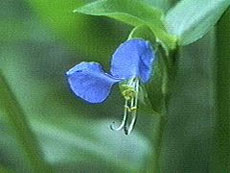
Question: Is the only good way to eliminate this invasive beauty from my garden to dig it up? J.T., no city given.
Answer: This is spiderwort, also called dayflower, since its lovely blue blooms each last only one day. It is modestly invasive, but it’s easily controlled with a sharp hoe and diligent attention to chopping out the shoots that try to come back. It will give up after a few attempts. Curiously, the cultivated big sister of this wild plant is a lovely shade perennial, and it will be featured in the next issue of our magazine.


